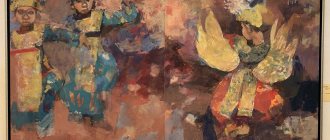Games in Sudan
Sudanese herrings have slightly different rules and are called “Lion and Antelopes”. The lion is the driver, and the antelopes are the other players. The antelopes must close their eyes at the beginning of the game, and the lion must hide from them under a bush or behind a tree. The antelopes scatter around the area, not knowing where the lion is, so he can attack them completely unexpectedly. The caught participants go over to the driver’s side and help him.
A very fun game, popular in Sudan, is called “Buffaloes in the Corral.” Its rules are very simple: All participants form a circle, 2 or 3 players stand in a circle. They are called buffalos. Their task is to break through the circle with their arms raised using their running power. Players standing in a circle must prevent the buffalos from escaping. Those who failed to hold back the buffaloes go to their place.
There are many more countries with their own interesting games. In many countries there are similar games that differ only in the presentation itself. For example, all over the world you can find a huge number of tags and blind man's buff. The popularity of games depends on both the climate and the spiritual values of a particular people. For example, games with oranges are very popular in African countries, as there are a huge number of them there. Games are often associated with folk traditions. Even if a person lives in another country, nothing stops him from trying to play a game that is so popular among foreigners. Such games not only lift your spirits, but also unite different peoples. It is necessary to introduce a child to the culture of the world, and it is best and most interesting to do this in a playful way.
Finland Games
Finland has its own version of bouncers. To play, draw a circle with a diameter of 8 meters. There are players in the circle, and behind the circle is the driver with the ball. His task is to knock out the player. The player who was hit by the ball leaves the circle and begins to help the driver. The following players also join. The last one left in the circle wins. The next game is called “Who has the item?” The driver stands near the chair and counts to fifty, and all the players hide within the pre-agreed territory. One of the players has an object, for example, a ball. The driver must find the player and touch him, then he is eliminated from the game. The driver must touch the player. His main task is to find the player with the ball. The driver should not move far from the chair, because If the player who has the ball runs out and puts the object on the chair, then it is considered that the driver has lost. The game starts again. Players can move around and tell the player with the item where the driver is now.
"I know five names"
The first player hits the ball from the ground with his hand, while saying: “I know five names of girls: Katya, Tanya, Sveta, Olya, Yulia...” You must speak quickly and rhythmically, for each word you must hit the ball with your hand. If the player is not lost, he continues: “I know five names of boys: Vanya, Kolya, Petya, Sasha, Misha...” Then, in the same way, you can continue to name five of everything that comes to mind: the names of cities, rivers, animals, trees, birds, car brands (some determine the sequence in advance, others create it on the fly). If a player loses the ball, makes a mistake, or takes too long to come up with an option, then the ball is passed to the second player, and he starts over: “I know five names of girls...” Repeating the same names and names is not interesting! When the ball, having made a circle, returns to the first player, he starts from the topic on which he lost his way. You can play “I Know...” not only with a group, but also with two people or even alone.
"Stander"
A half-forgotten game from the repertoire of pioneer camps. Judging by the name (most likely from Ständer! - “Stand!”), it was borrowed from a German game collection. To play you will need a ball. A large circle is drawn on the ground - all participants must fit into it. Then one person tosses the ball, calling the name of any other player. Everyone runs in different directions, and the named player leads. He catches or quickly picks up the ball from the ground, after which he shouts: “Stander!” - and everyone else must stop. The driver needs to knock someone out with the ball: he chooses his target (usually the player who is closest to him), takes three steps towards him and tries to hit him. He can cheat and step in one direction and throw the ball in the other so that the unsuspecting player does not have time to dodge. If the driver hits, then the “beaten” one receives a penalty point; if not, the driver gets a penalty point. In the next horse, the same driver throws the ball and calls the name of the player who will take his place. At the end of the game, the points are added up and the one with the least is declared the winner.
"Traffic light"
On the site, two lines are drawn at a distance of 3–6 meters from each other - a road passes between them. The driver - the traffic light - stands in the middle of the road and cannot go beyond the lines. The rest are in front of the first line, and their task is to cross to the other side, that is, to end up behind the opposite line. The traffic light stands with its back to the players and makes a guess about the color: for example, it announces that it will only let red into the other side. Each player begins to look for some red thing on himself; its size and purpose are not important, and even a small spot on the pattern can be red. After some time (for example, after counting to ten), the driver turns around, and those who managed to find the right color present it to the traffic light and calmly cross the road. Everyone else is trying to run to the other side, but the traffic light catches them. The one he caught becomes the new traffic light. It makes sense for the driver to name unusual colors - lilac, turquoise, etc.: then there will be more of those who do not find such a color on themselves - and he will be able to catch a player to replace him.
"Ring"
This game is very old, known as "Bury Gold" since at least the early 19th century, but most likely existed much earlier. The game “Burying Gold” was part of the Yuletide entertainment for young people, especially girls: the song that accompanied the action was filled with marriage images (a tower, a viburnum-raspberry, a light brown braid, a ring falling to a young nobleman) The lyrics of the song were, for example, like this : “I’m already gold / I’m burying, I’m burying, / I’m burying pure silver. / I’m with my father in the mansion, in the mansion, / I’m with my mother in the high, high. / The ring fell, the ring fell / Into the viburnum-raspberries, / Black currants; / The ring ended up / Yes with the nobleman, / Yes with the young man / On the right hand, / On the right little finger. / Guess, guess, girl, / In which hand was the girl, / Walking across the field, / Weaving a braid into Russia, / Weaving in silk, / Weaving in gold, / The girl was guessing, but didn’t guess. / You are my girlfriends, you are mine, you are mine, / You tell me, don’t hide, / Give me my gold: / My mother will beat me / Three mornings, four, / Three golden rods, / Fourth pearl. / The girls guessed, but didn’t guess; / Gentlemen of the nobility, guess for yourself” (A. V. Balov. “Russian round dance”. Round dance games in the Yaroslavl province / Northern Bulletin. St. Petersburg, 1889. No. 6). and could be performed during fortune telling. By the end of the 20th century, the game lost the long song, the connection with Christmas time and the magical meaning, only the action and the name of the game item remained - the ring. Although a ring is not necessary: “Ring” can be played with any small object - a coin, a button, a paper clip, etc. Participants sit in a row, fold their palms like shell flaps, and hold them in front of them. The driver, who has a “ring” in his hands folded in the same way, approaches everyone in turn and lowers his hands into the player’s hands. He places a “ring” in the hands of one of the players, trying to do it unnoticed. The one who got the “ring” also tries not to give himself away. The others, in turn, watch carefully, noticing who is behaving unusually and suspiciously. After all the players have been bypassed, the driver steps aside and says: “Ring-ring, go out onto the porch!” The player with the “ring” quickly jumps up and runs towards him. Other players, especially if they realized in advance who has the “ring,” try to grab it and hold it in place. If the player with the “ring” manages to escape, then he leads the next horse; if not, the previous player remains leading.
At the playground. 1981 © Vitaly Karpov / RIA Novosti
Sweden Games
The game “Burners” is popular in Sweden, only here it is called “Last pair - go!” Players are divided into pairs and stand one after another in a column. The driver stands in front of the column with his back to the players. He shouts: Last pair - go! The last pair of the column runs forward, one player runs around the column on one side, the second on the other. The players’ task is to stand in front of the driver and hold hands. The driver's task is to grab one of the players by the hand faster than his partner does, while the driver is not allowed to look back or turn around.
The game "Barrier" is played with a large number of people. The players stand in ranks. The number of players in each row depends on the number of rows themselves, for example, you can make five rows of five people, or 7 rows of seven people. Players in the same row join hands. This creates streets along which one player will try to catch up with the other. All players are on the side of the runner, and if the second player catches up with him, then the leader gives the command and the players must suddenly lower their hands, turn to the left and hold hands again. Thus, the direction of the streets changes and the pursuer ends up two streets away from the escapee. The game continues until the runner is caught. In Sweden they also love to play dodgeball with snowballs. Players are divided into two teams and take turns trying to hit the enemy with snowballs. If you miss, the turn goes to the other team; if you hit the enemy, the right to throw remains with the team. Sometimes entire fortresses can be built from snow for this game, and then the game becomes like a battlefield.
"Twelve Sticks"
One of the varieties of hide and seek, but with an interesting complication. Before the start of the game, participants choose a driver and build a special structure: a board is laid on a stone, brick or other object of suitable size so that one end of it lies on the ground and the other is raised up. Twelve small sticks are placed on the lower end of the board (pencils or brushwood can be used), and then, using the board as a lever, one of the participants scatters them. While the driver collects sticks, the players hide. Then, as in standard hide and seek, he goes to look for those hiding and, if he finds them, he snitches, that is, he runs to the base. Or, as the driver’s place was previously called, to the “con” or “fat”. and shouts something like “Knock-knock for Petya!” The essence of the complication is that during the search you must not forget to guard the structure made of sticks: the discovered player can run to the board before the driver and destroy everything (at the same time he must shout: “I broke it!”). Any other player can do the same if he notices from cover that no one is guarding the base. If the sticks are scattered, then the driver must give up searching and reinstall the structure, and the one who scattered the sticks and the other players hide at this time. It is quite difficult to get rid of the role of the driver in such a game.
Malaysia Games
In Malaysia, children often play the game "Turtle's Nest". A circle with a diameter of one and a half meters is drawn on the ground. This will be the turtle's nest. You need to put 5 stones in the circle - these are turtle eggs. The turtle stands in a circle and guards the eggs. All other players are robbers; they are outside the circle, but can run inside it and steal eggs. This must be done so that the turtle does not catch the players. Whoever the turtle touches takes its place. When all the eggs have been stolen, the turtle must close his eyes and the players hide the eggs. The turtle's task is to find them. If he doesn't find all the eggs, he makes his wishes come true. Another game for younger children is “Whetstone”. Participants stand in a circle, with the leader and another player standing a few meters from the circle. The presenter gives the command: “Sharpen, sharpen!” and then immediately says some task, for example, jump on one leg, shake your head, dance, etc. The players standing in the circle must immediately complete it, and the player standing next to the leading player must grab one of the players faster than he begins to complete the task. If he succeeds, the players change places.
Japanese games for kids
Among the games for children in this country, “Japanese Blind Man's Bluff” and “Nose, Nose, Nose, Mouth” are popular. The essence of the game “Japanese blind man's buff” is as follows: the participants form a circle, and in the middle there is a blindfolded driver. They call him a bird. All participants dance around him and say: “Bird, bird, locked in a cage, when will you come out to me, my bird?” After some time, the circle stops and the driver is asked: “Who is standing behind you?” If the driver guesses correctly, then the person named by him stands in the circle, if not, then the game continues until the driver guesses the player standing behind him. The second game has its roots in the USA, but it became popular in Japan. The players must sit in a circle, with the driver sitting in the middle. He says the following words: “Nose, nose, nose...” (any other part of the body). With the first three words, he touches his nose, and on the last word he abruptly touches any other part of the body, but not the one he named. The players’ task is to touch themselves on those parts of the body that the presenter names, and not on those that he shows. If a player is knocked down, he is eliminated. Whoever remains last wins.





